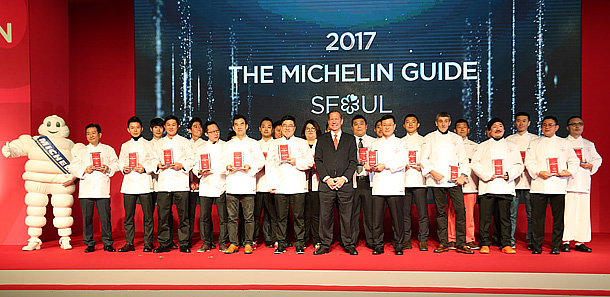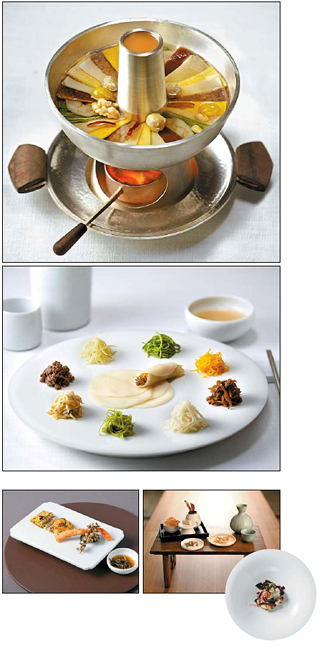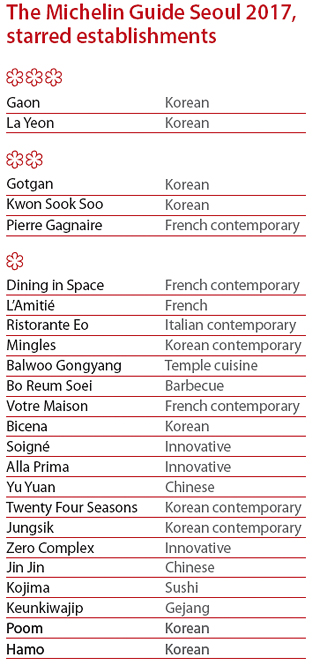Michelin gives stars to 24 restaurants in Seoul

The Michelin Guide, a restaurant guide by French tire company Michelin, released its first Seoul edition yesterday. Michael Ellis, international director for the Michelin Guides, center, poses with chefs from 24 restaurants that won stars. [WAGTI]
The Michelin Guide by the French tire company gave stars to 24 restaurants. Only two got the highest honor of three stars. Both serve Korean food with a modern form of plating inspired by Western fine dining restaurants.
Korean restaurants accounted for 11 out of the 24 that got stars. No Korean street food was honored, despite the fact that Michelin awarded one star to street vendors in Singapore in July.
“Seoul has emerged as a most exciting and dynamic dining destination,” said Michael Ellis, international director for the Michelin Guides.
“The quality and diversity of the amazing cuisine here delighted our inspectors and [we] discovered many exceptional restaurants, and I’m thrilled to tell you how unique the food in Seoul is.”
La Yeon at the Shilla Seoul hotel in Jangchung-dong, central Seoul, and Gaon in Sinsa-dong, southern Seoul, according to Ellis, really proved the “sign of the quality.”
“They are what we look for in three-star restaurants,” he said, singling out abalone dishes at both restaurants that were “cooked perfectly” with unique sauces and garnishes. “At those restaurants, chefs are artists expressing their art [by] taking ingredients and make them sublime, and they deliver memorable experience and give some emotions when you are eating.”
The starred restaurant list included Keunkiwajip in Samcheong-dong, central Seoul, known for gejang, raw crabs marinated in soy sauce. Gejang has been spotlighted in the media as one of the most exotic dishes in Korea. It was awarded one star.
“The arrival of the Michelin Guide will generate a considerable amount of tourists coming in and discovering Korean cuisine beyond Korean barbecue, bibimbap, and kimchi, three things people know as Korean food,” said Ellis. “They [can] discover just how varied, how rich, and how completely unique food is in Korea.”

Korean restaurant Gaon in Sinsa-dong, southern Seoul, won three stars, the highest honor. The restaurant serves dishes (above) made with local ingredients with simple plating. The Shilla Seoul Hotel’s Korean restaurant La Yeon is another restaurant awarded with three Michelin stars for its dishes (right). [GAON]
Balwoo Gongyang, which serves Korean temple food - which is trendy for its use of a wide variety of vegetables - also got one star.
Five French restaurants were given stars, including the Korean branch of Michelin three-star-winning Pierre Gagnaire at the Lotte Hotel Seoul, central Seoul. The restaurant won two stars.
Zero Complex in Seorae Village, southern Seoul, run by chef Lee Choong-hoo, who worked previously at Le Chateaubriand, a French bistro in Paris, was awarded with one star, although the Michelin Guide categorized his cuisine as “innovative” instead of “French.” Single stars were also awarded to Dining in Space in Wonseo-dong, central Seoul, and chef Noh Jin-sung; Votre Maison in Sinsa-dong, southern Seoul, and chef Park Min-jae; L’Amitie in Sinsa-dong, southern Seoul, and chef Jang Myoung-sik.
Only one Japanese restaurant, Kojima in Cheongdam-dong, southern Seoul, and two Chinese restaurants - Jin Jin in Seogyo-dong, northwestern Seoul, and Yu Yuan at the Four Seasons Hotel Seoul in Jung District, central Seoul - were awarded single stars.
“There definitely has been a premium on Korean food, as foreigners naturally want to try different versions of Korean food,” said a local chef who asked not to be named. “To make the overall scene more varied with different styles, I hope other cuisines get more attention in the future.”

The Michelin Guide awarded three restaurants two-star ratings. Dishes served at Gotgan (above left) in Yeouido, western Seoul, Kwon Sook Soo (above right) in Gangnam, southern Seoul and Pierre Gagnaire in Jung, central Seoul received two stars. [The Shilla Seoul, GOTGAN, KWON SOOK SOO, PIERRE GAGNAIRE]
The arrival of the guide has been creating a buzz among food aficionados curious about the level of Korea’s dining scene. Michelin has extended its reach. This year alone, the French guide extended its presence to three cities in Asia: Shanghai, Singapore and Seoul. Shanghai now has 26 Michelin-starred restaurants with one awarded three stars. Singapore has 29 starred restaurants with one awarded three stars. There are currently 2,700 restaurants worldwide awarded with stars, and the top honor of three stars has been given to 111 restaurants.
“The fact that Korea has one more Michelin three-starred restaurant than Shanghai and Singapore is something promising,” said Jang Jin-mo, who used to run a restaurant in Seoul.
“While restaurants that do local Chinese food in Shanghai were a bit underrated, we can conclude that Korean food was given respect since both three-star restaurants do Korean food.”
Lee Yun-hwa, president of Diary R, which reviews restaurants in Korea, said she now looks forward to future editions of the Michelin Guide to see how they will update their evaluations.

She warned readers should be cautious in taking suggestions from just one guidebook, because it simply gives a subjective list of places. It is the diner’s job to choose what is to their likes and dislikes.
“By only using a Michelin Guide in a city, one may not find food that suits your palate, but you should be able to find restaurants that serve good quality food,” said Lee Yun-hwa, president of Diary R.
“Diners will have to see if the guide’s rating system suits them and decide whether to follow them or not, just as we do with movie critics.”
Korea also welcomed the release of the Bib Gourmand list by the Michelin Guide, released on Nov. 1. It introduced restaurants with meals that cost less than 35,000 won. It includes Korean restaurants that serve different styles of noodles, such as naengmyeon, buckwheat noodles in cold beef broth, and kalguksu, flour noodles in either beef or seafood broth, and many places that serve dumplings.
However, no restaurant known for rice dishes was chosen for the budget list.
“Korea is the country where people live on rice, not noodles,” said Kim Eun-jo, editor-in-chief of a local restaurant guide, the Blue Ribbon Survey.
BY LEE SUN-MIN [summerlee@joongang.co.kr]










with the Korea JoongAng Daily
To write comments, please log in to one of the accounts.
Standards Board Policy (0/250자)